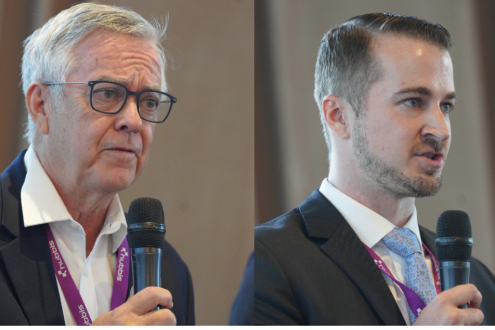Taking a 360-Degree Look at Moving to Higher Tax Countries, Smart Tax Planning and Life Solutions

Oct 5, 2023
In a novel twist on the typical Hubbis live event Workshop, Peter Triggs, Partner of life insurance specialist 1291 Group and Scott Moore, Managing Director at investment migration firm Henley & Partners, tag-teamed to give delegates some useful advice around planning for HNW and UHNW clients moving to higher tax countries. The objective was to help wealth managers at the event consider some of the issues their clients face in making these major decisions for themselves and family members, and to proffer some preliminary guidance on the right approaches for specific countries, such as the US, Canada and Australia. This is a short summary of some of the information, ideas and advice they shared.
Even though many individuals and families in Asia obtain residence by investment overseas, they very often stay exactly where they are – seeing those alternatives more as a fallback or as part of a future plan. But when people actually move, some serious tax and compliance planning is needed. They might be switching legal systems, there might be issues around moving from Shariah jurisdictions, and there will inevitably be tax implications.
“The specific tax advice will remain the purview of tax lawyers, but you in the wealth management industry need to understand these issues, highlight them to clients and then help them with advice around structuring and execution,” Peter told guests.
The different types of tax systems
They first pointed to different tax systems. Source-based or “territorial” taxation is practised in Singapore, Hong Kong, Malaysia, and Thailand, amongst others. Residence-based taxation is seen in the UK, Canada, Australia, France and numerous other countries, with differences in interpretation amongst them on what defines residence. The US is alone in the practice of citizenship-based taxation, aside from Eritrea, while China is alone in having a domicile-based income tax regime. There are some countries with no personal taxes, including the UAE, BVI, the Bahamas, Brunei and others.
Peter explained that along with very high rates of tax in high-tax countries – such as 45% in Australia and the UK – the extreme global reach of residence-based tax systems to any income from any part of the world can come as a major shock to Asian clients moving to those or any other countries that have the same or similar regime.
“In Malaysia, Singapore, Thailand you are taxed only on what you earn locally in that territory, so essentially your investments overseas are free from local taxation,” he noted. “It is a very benign approach.”
Australia’s ‘golden’ shores
The two speakers then turned their attention to Australia, with Scott pointing to the Australia Business Innovation and Investment Program, and its requirements for entry.
For the Business Innovation Stream, individuals must pass a points test, have a successful business career with a business turnover of at least AUD750,000, and net assets of at least AUD1.25 million. For the Investor Stream, individuals must pass a points test and commit AUD2.5 million into a complying Australian-managed investment fund for the duration of the provisional visa validity.
The Significant Investor Stream opens the door to individuals committing at least AUD5 million into a complying Australian-managed investment fund for the duration of the provisional visa validity.
“Those are the three options,” Scott reported, “but actually the government is not currently accepting new applications, as they are overhauling the current residence by investment programmes and new programmes will appear as of July 1, 2024. We think only the significant investor visa will survive, by the way.”
He explained that the biggest advantage of this particular visa is the applicant only needs to spend 40 days per year to maintain residence and can apply for permanent residence if they rack up at least 40 days annually for four years, or they can extend the 40-day rule for up to eight years.
Scott also highlighted another route, namely the Entrepreneur Stream, or the Global Talent initiative, for individuals who receive endorsement by a state or territory government, and which he said continues to attract specialists such as resource engineers, technology professionals, fintech experts and others.
“This is a programme where they just look at your CV, and you might then get a permanent residence within about nine months, and then you have four years to decide whether or not you want to move to Australia,” he explained. “No investment needed, only the right profile and talent.”
Solutions available for Australia
Peter then proposed methods for mitigating tax exposures for those moving there and faced with taxation on worldwide income and gains, income tax rates up to 45%, another 2% for Medicare, and capital gains taxes (albeit this is usually given a 50% discount and then added to income with the income tax rate being applied to the total).
He explained that if assets are placed as a premium into a Private Placement Life Insurance (PPLI) policy then there are several advantages. Income and gains within the policy will not be taxable and can accumulate tax-free. After 10 years, any distributions from the policy to the Australian resident will be completely tax-free in Australia (while distributions in 9th and 10th years are only partially taxed).
Moreover, he reported that the Australian Tax Office (ATO) had recently issued a formal ruling confirming that this is the case, and that the use of such policies is not caught under the general tax anti-avoidance provisions.
He added clients can use this structure to go there to retire and live totally tax-free in Australia. He said they can even structure a trust on top of the PPLI, to enhance asset protection for the next generations.
The UK is still in the game
Scott then turned to the UK, commenting first that Australia APPEARS to be superior in many ways, including the clarity around treatment of mitigation vehicles such as PPLI. He explained that the UK options had shrunk since Russia invaded Ukraine, with the TIER 1 INVESTOR Visa BEING instantly cancelled for political purposes.
The visas that are still available tend to focus on economic development, especially innovation and new businesses.
“With the right qualifications and profile and plan, the UK government, like in Australia, will open the door to foreign entrepreneurs, and innovators,” he explained.
“The UK is also a major education destination with study visas also available, with parents, perhaps the mother, potentially able to come in as well on a caretaker visa, while perhaps the father stays in Asia earning money and not being exposed to UK tax.”
Scott reported that the UK might likely scrap its indefinite resident non-domicile visa which is remarkably tax advantageous for HNWIs. “The Labour Party looks likely to gain power at the 2024 election,” he said, “and had said it will scrap this avenue as they deem it too beneficial for very wealthy people.”
Sidestepping punitive taxes in the UK
Peter took the podium, adding that those who are still under that visa and with whatever number of years left on it, should plan to mitigate tax exposures. UK residents are taxable on worldwide income and gains.
He noted that in the UK Income Tax rates go up to 45% and Capital Gains tax up to 28%. However, if assets are placed as a premium into a Private Placement Life policy, then income and gains within the policy will not be taxable and can accumulate tax-free, distributions from the policy to the UK resident will be completely tax-free in the UK provided that they do not exceed 5% of the initial premium.
This means the UK-resident individual could receive 5% of the assets per annum for 20 years, or perhaps 2.5% per annum for 40 years, with the first 100% of payouts treated as a return of capital invested. The policy can also be transferred to an excluded property trust to keep the assets 100% outside the UK Inheritance Tax net, which kicks in at an incredibly low GBP325,000, above which 40% is levied.
“My advice is to take action early if moving to the UK, put your PPLI policy into an offshore trust, and you're in the perfect tax situation,” he stated. “The one caveat is under the UK rules, you cannot continue to manage your investments, so typically, people can have a discretionary portfolio.”
The US still appeals
Scott turned to the US, explaining briefly about the US EB-5 Immigrant Investor Program, which he said is very straightforward. The applicant must be able to prove the source of their funds, invest in a commercial enterprise associated with a government-approved regional centre, either to the tune of USD800,000 into a targeted employment area project in a rural area or an area with high unemployment, or USD1.05 million into a non-targeted employment area project, and finally create or preserve 10 permanent full-time jobs for qualified USA workers.
After the green card (EB-5 visa) has been issued, the funds must stay invested for at least five to six years. Of course, these are investments that should be returned to the investors. Scott stressed the importance of Henley & Partners’ advice in recommending a reliable regional centre.
And there are tax mitigation opportunities
Peter then zoomed in on some tax mitigating opportunities, for those who have a green card are then immediately US tax-paying residents and therefore taxable on worldwide income and gains. Income Tax rates go up to 37%, while CGT is usually 20% but can be higher.
However, if assets are placed as a premium into certain types of Life Policies, then income and gains within the policy will not be taxable and can accumulate tax free, and if the policy is regarded as a Modified Endowment Policy (MEC) then distributions from the policy will be taxed first as income. The MEC is similar to PPLI and offers immediate tax deferral, no reporting and zero tax to pay. Peter explained that these policies can be funded with a one-time transfer of assets, especially useful for people who are moving temporarily to the US.
Moreover, if the Policy qualifies as a ‘non-MEC’ policy then distributions will be taxed first as principal (tax-free) and it is possible to structure these to create a permanent tax-free shelter. These policies need to be funded over a period of years, usually 7 years, but it can be less. They do require significant life cover and discretionary management of the investments.
He said these would be recommended for Foreign Grantor Trusts, for post-grantor planning, for US persons, or for Asian families with family members moving to the US. “People who should think about this include trustees, who have set up foreign grantor trusts or are managing foreign grantor trusts, but hadn't thought about what happens when the grantor passes away,” he added.
Canada beckons
Scott then highlighted some appeals of Canada, which he said is particularly interesting for families sending their children to school there, as anyone with a residence permit is going to save at least USD100,000 on just an undergraduate degree.
He noted that Canada is the second-largest country in the world physically, as well as one of the wealthiest. Investors benefit from the country’s status as one of the best countries to live in and its high standard of living and open and tolerant culture. And Canada is open to immigrant entrepreneurs, with the Canada Start-Up Visa Program proving very popular, especially as people can then obtain permanent residence in Canada within two years.
Peter turned to solutions to income tax rates that go up to 33%, and noted that like in Australia, 50% of capital gains is included in income. There is no estate tax or IHT in Canada, but there is CGT on death for assets that have appreciated.
He told guests that planning with insurance policies is limited to policies which pass the ‘Exempt Test’. This is an actuarial test that is normally only fulfilled by Variable Universal Life-type structures. The maximum face value is generally C$65 million.
Peter said trust planning is now also more complex, although ‘Granny Trusts’ which involve a non-Canadian resident setting up a trust for Canadian residents remains an effective planning technique.
“You don't need to have a real granny,” he quipped, “but you do need to have somebody set up the trust who is not going to Canada, in other words, you can leave granny behind.”
“Actually, the rule is that whoever it is who holds the trust, the only requirement is they do not go to Canada.”
And with that, they rounded off what was a valuable addition to the Summit from both the insurance/tax mitigation aspect and also relating to relaying investment migration options that are often taken up by wealthy Asian families for a variety of reasons.








